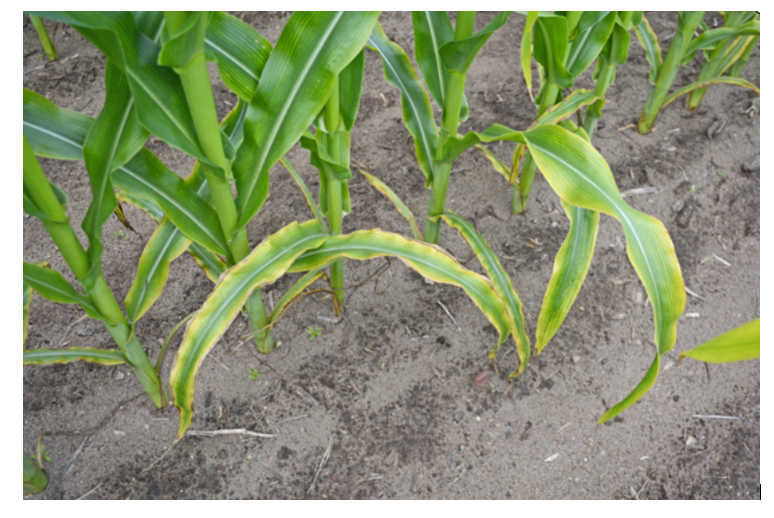2 Ways to Tell Whether Corn is Deficient in Nitrogen or Potassium

When it comes to stressed corn plants, pictures can help explain what you’re seeing in the field better than the proverbially thousand words – especially this time of year, says Ken Ferrie, Farm Journal Field Agronomist.
Ferrie says a picture he is seeing develop in cornfields across central Illinois right now is one of potassium (K) deficiency.
The problem is mostly due to dry soil conditions that have contributed to poor crown root development, rather than an insufficient amount of the nutrient in the soil (picture by Daniel Kaiser, University of Minnesota).

The situation is one of cause and effect: the lack of moisture contributes to insufficient root development which results in roots that are unable to pull a sufficient amount of the nutrient into the plants.
Along with dry soil conditions, here are six other common contributors to a potassium deficiency in corn:
1. Cold soils
2. Compacted soils
3. Sidewall compaction
4. Potassium stratification
5. Root pruning
6. Anything affecting or restricting root growth
What Does A Potassium Deficiency Look Like?
Potassium uptake accelerates rapidly after about the V6 growth stage (approximately 4 to 6 weeks after corn planting). So, when the K demand becomes large, effects of reduced uptake become most visible, according to Iowa State University Extension.
During this same time, it’s easy to confuse a potassium deficiency with a nitrogen deficiency. Both nutrients are mobile in the plant and move from the oldest to the newest part of the plant, but they look different on a corn leaf.
Here’s how to distinguish between the two problems, Ferrie says:
1. A nitrogen deficiency starts at the tip of the leaf and comes down through the mid-rib, so there will be a V-pattern through the mid-rib.
2. A potassium deficiency starts at the tip of the leaf and then goes down through the outside of the leaf. Along with that, symptoms of a potassium deficiency appear on the lower portion of the corn plant first. Older leaves can entirely discolor, crinkle, curl, roll along edges, or die and drop prematurely.
Don’t assume your problem is a potassium deficiency or a nitrogen deficiency as the assumption can have negative consequences.
“If you apply more nitrogen when there’s a potassium deficiency, you can actually make the potassium deficiency worse,” Ferrie says. "If you suspect corn is deficient in potassium, follow up your scouting with tissue testing to see what’s going on inside the plants."
Can I Correct A Potassium Deficiency In-Season?
Taking an effective corrective measure for potassium in-season is challenging. If you have adequate levels of K present in the soils, your best hope is to get rainfall (or use irrigation) to improve nutrient uptake.
If plants fall behind on K uptake, it’s almost impossible for them to catch up later in the season, according to Daniel Kaiser, University of Minnesota Extension nutrient management specialist.
“You don’t want to be reactionary with K,” he told Farm Journal earlier this spring. “It’s better off to apply ahead of planting so plants can constantly feed off it in the growing season. There has been a lot of talk about foliar applications of K, but it has to go through the roots,” he adds.
Illini FS agrees with Kaiser’s take in those corn-production situations where there is a true K deficiency in the soil.
“Soil application of potassium in season is not usually an option unless liquid or dry potassium can be banded close to the plant roots,” according to the company.
But the company adds, “Foliar-applied fertilizers containing potassium may be of help depending on the severity and underlying cause of the deficiency. Temporal deficiencies due to soil environmental conditions and moisture stress stand the best chance of success from foliar fertilization due to a low dose of potassium contained in foliar products.”
Learn more about how to effectively manage potassium here:
What You Need to Know About Potassium
Be More Than Oh-K: How To Manage Your Field's ...
Hear this week's Boots In The Field podcast here:







